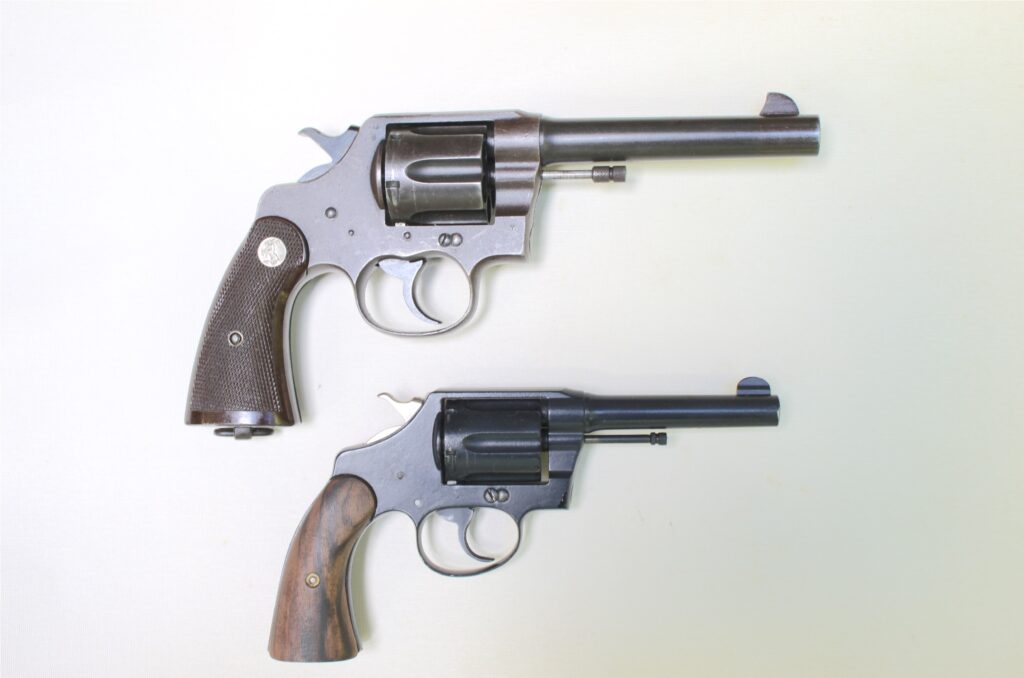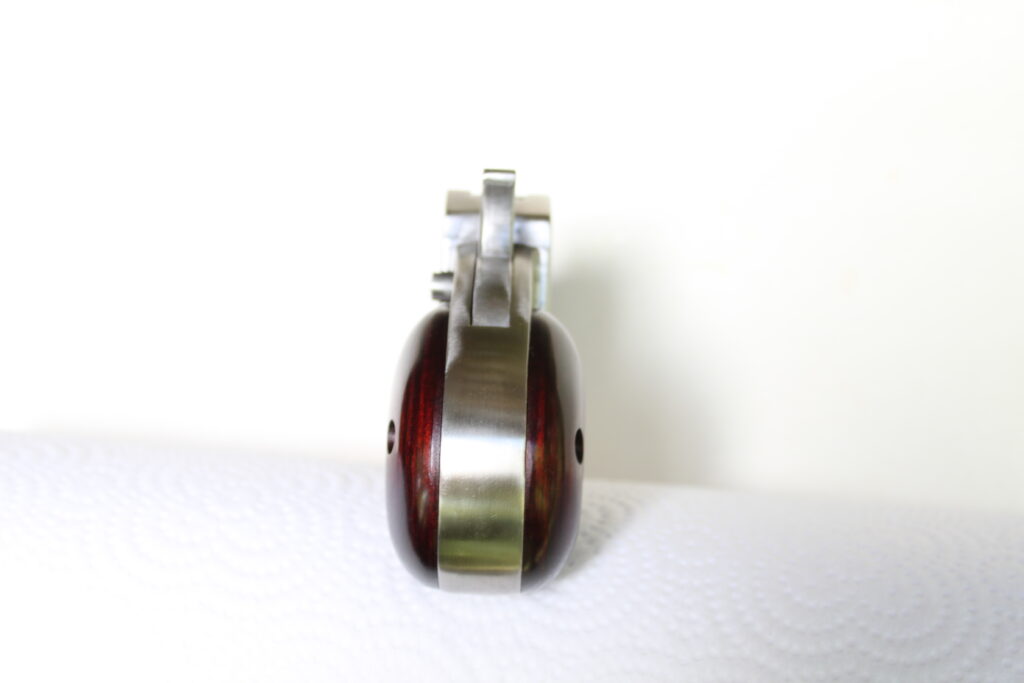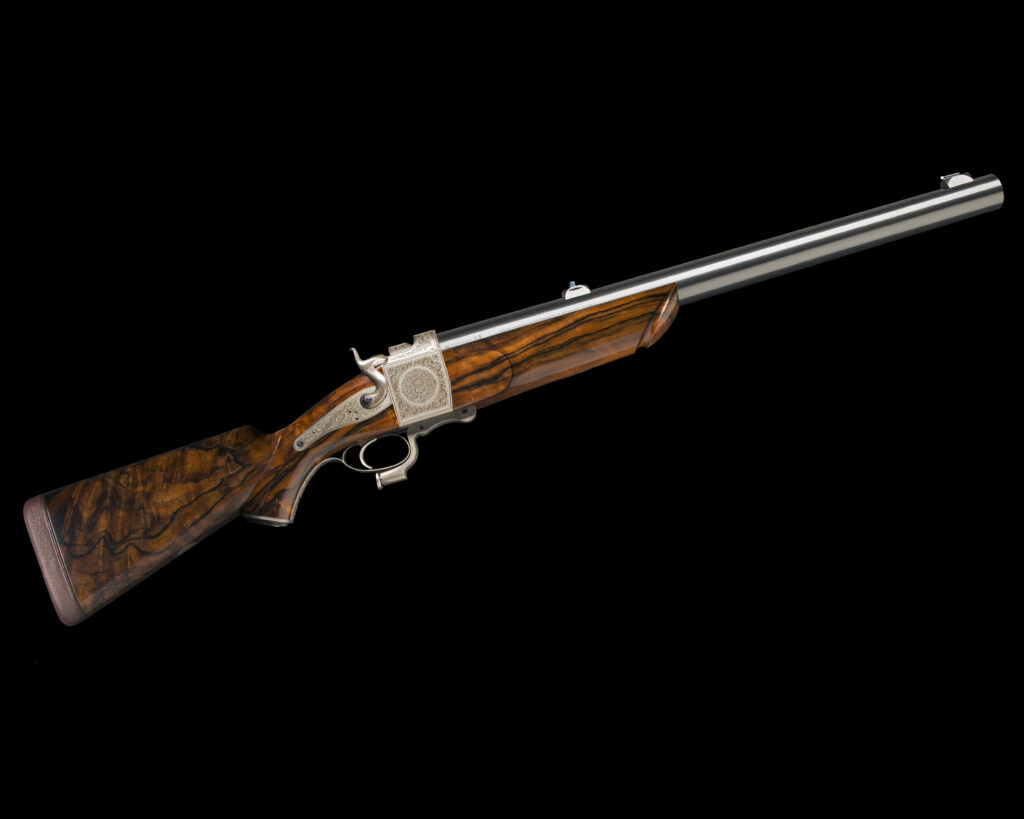
By Jim Dickson | Contributing Editor
Gun weight is your friend. It makes the gun steadier to hold and absorbs recoil.
Don’t get sucked in by salesmen pushing lightweight guns as these can turn even a low powered cartridge into a real kicker. A while back a man broke a bone in his hand shooting one of the super light nonferrous alloy revolvers at one of the training centers. The general opinion of most experts is that these extreme featherweight revolvers are really single shots because after the first shot your hand is so injured you won’t be able to get a second shot off in a gunfight.
Even the puny .38 Special has a very noticeable recoil in a regular lightweight revolver with wood grips. The 20-ounce Colt Police Positive and the 18 ounce 5 shot S&W Regulation Police with their sharp recoil were considered by many police to kick too hard. They do kick noticeably more than a 39 ounce .45 Colt New Service revolver which is a proven manstopper, something the .38 Special has always fallen short of. The average police department preferred the S&W M10 M&P at 31 ounces and the .41 frame Colt Army Special at 32 ounces. The U.S. Border patrol went so far as to adopt the 44-ounce Colt New Service revolver in .38 Special. That seems a pretty extreme length to go to get rid of recoil to me. Recoil was the reason that so many .357 magnums made for police sale were decidedly overweight. I well remember one that weighed more than a .44 Magnum. That’s taking things a bit too far but it shows what a problem many folks have with recoil.
One of the reasons the turn of the century top break revolvers in .38 S&W caliber were so popular is that they had negligible recoil yet were still extremely light and compact. In fact, they were the ultimate small .38’s. Extremely easy to hit with the public loved them because they worked. Unfortunately, the .38 pistol can never be a manstopper. As the Army’s Thompson La Guardia Commission Report stated “Nothing less than a .45 caliber 230-grain bullet at 800 to 900 FPS can be depended on to stop a man.”
Efforts to increase the lethality of the .38 led to the .38 special and then the .357 Magnum but the failures continued. You can’t make a Tiger tank out of a Volkswagen. The increased velocity was a lot more effective in increasing muzzle blast and recoil than it was at increasing stopping power.

Once the velocities exceeded the speed of sound at 1100 FPS a sonic boom was added to the already greatly increased muzzle blast of the magnums resulting in a lot of permanent hearing loss in the shooters.
If you want the smallest practical compact pocket .38 you will be best served by the old top break .38 S&W caliber guns. If you want stopping power, you must have a .45. A M1911A1 is the perfect size for proper balance of compactness, weight, and recoil control. This is critical as rapid-fire is impossible with heavy recoil. The M1911A1 bounces in your hand more than it recoils when fired and its recoil is by no means punishing. The old Colt M1873 Single Action Army is another pleasant .45 to shoot as it has just enough weight along with well-designed grips. The massive Ruger Redhawk 4-inch barrel .45 Colt double action revolver is a joy to shoot with its fine double action trigger pull and lack of recoil. The rubber grips help reduce the kick but the size and weight are what really tame the recoil.
Big hand filling wide grips always are a help. The American Derringer Co.’s .45 Colt/.410 double Derringer has wide much wider grips than the early Remington .41 rim fire double Derringers that were its inspiration. Get a tight grip on the .45 Colt double Derringer and it is not bad to fire.
Recoil in rifles is where things get dramatic. Giles Whittome, a Best Quality English gun maker, produces 2 bore single shot rifles. These are the largest and most powerful sporting rifles ever made and they have the kick to go with it. Indeed, the maximum load the guns will take is generally considered to be lethal to anyone foolish enough to fire it so the loads are tailored to whatever the individual shooter can stand. Stand takes on new meaning when you see a man standing behind new shooters to catch them when it shoves them back upon firing this monster shoulder fired cannon.
Lesser elephant rifles can also hurt. The proper weight for a .500 Nitro Express is 12 pounds and 14 will make it much more pleasant to shoot. A few years ago I had to put 160 rounds through a lightweight 10 pound .500 Nitro Express that had more felt recoil than a 14 pound .577 three inch Nitro Express. I don’t intend to do that again. I am not going to put up with the recoil of a lightweight .577 three inch nitro express in a gun that doesn’t deliver the power of a .577 nitro express. That’s just crazy. The only reason you put up with the tremendous recoil of a .577 is the unbelievable power it delivers on game.
Several years ago there was an ad for a 7 pound .500 nitro with 18 rounds of ammo. The following month it was for sale again with a new owner and 17 rounds of ammunition. This continued for several months with each new owner only firing it once. Finally, someone bought it and sent it to the gunmakers to have sufficient weight added to it to make it shootable.
Minimum weights are critical to heavy calibers. Without it you cannot practice with them effectively and your life depends on practicing with the gun you hunt dangerous game with. You have to be able to shoot it more than a couple of times a day. Eleven pounds is the minimum for a .470 and 12 is better. A .450-400 should weigh 10 to 11 pounds. Anything lighter than 10 pounds and you will have problems holding it steady when you are tired and out of breath.
A perverse practice among sportsmen is to cut down military rifles to “Sporterize” them. This invariably leads to a drastic increase in recoil which is very detrimental to their shooting. Long 28 and 30 inch barrels are bobbed off to 24 and 22 inches despite the fact that these long barrels are steadier to hold on target and reduce the muzzle blast by putting it further away from your ears. Military rifles are already as light as they can be and still fire a 100 shots a day through them. If you don’t fire at least that many rounds a day off hand you will never get really good with that gun.

Military rifles are heavily reinforced to take all the hard knocks without failing. So-called “Sporters” from the commercial makers are designed to make money for the maker first and last. They are not going to spend extra money on wood and metal fittings if they don’t have too. Their stocks are narrow which means they do not spread the recoil out over as large an area as a broad military butt plate.
The 1 ¾-inch wide oval military butt plates may be steel but they cut down recoil far more than the narrow hard rubber recoil pads you see everywhere. If you want to cut down recoil with a recoil pad, then make sure it is at least 1 ¾-inches wide and made of sorbothane instead of the normal ventilated hard rubber recoil pads. If the standard factory recoil pads do anything at all to reduce recoil, I cannot tell it.
The M98K Mauser is a good example of a military bolt action. While the American 8MM Mauser ammo is loaded down to about 30-30 levels the European loads hit more like a .338 magnum yet I can’t feel the recoil from the European loads in a standard military M98K. Put the barreled action from that gun in a slim lightweight “Sporter” stock and I guarantee that you will feel it to the detriment of your shooting.
To lighten a gun so that it has the recoil of a much more powerful gun but without the power of the heavier caliber makes no sense at all.
There is a rule in the Best Quality gun trade of the British Isles that a shotgun must weigh 96 times more than the shot charge thrown for recoil to be bearable under a long day of driven game shooting. Your shoulder should not be black and blue at the end of the day.
It is important not to overload the powder charge in a shotgun because aside from increasing recoil powder overloads scatter the shot pattern wide. I have used one 12-gauge load all my life for everything I shoot with birdshot. One ounce of #6 shot over 3 drams of powder. At what is normally regarded as maximum range for a shotgun I have shot clean through the heavy feathers and bones of wild turkey with this load. It produces unbelievably even patterns at 50 yards through my English double game gun.
Another thing that helps you mitigate recoil on these hunts is the practice of having the gunstock fitted individually to the shooter. This makes a very noticeable reduction in recoil aside from its intended purpose of forcing the gun to point exactly where you are looking when it is mounted correctly.
Some men want a light easy to carry gun but what good is it if it is so light you can’t hold it steady when you are tired and the increased recoil prevents you getting sufficient practice firing off hand to get good with it? The proper solution is to get in shape. Lift weights, jog, hike, and don’t forget to condition your feet in the boots that you will be wearing afield so you don’t get blisters and ruin a big hunt. That all too common occurrence has ruined many hunts of a lifetime.
I am a strong man who likes to shoot. A lot. Personally I want a heavy double rifle that is heavier than normal so I can shoot more each day. If I were having a new .577 Nitro Express made I would want it to weigh 18 pounds. 15 pounds is OK for that caliber, 14 pounds is only tolerable, and at 13 pounds it starts to hurt. Below that I don’t want to fire it. I don’t need a gun headache. For those who say I can’t carry a heavy gun as far I point out the difference in our size and how that makes a difference in what you can carry. I would also demand a 1 ¾ -inch wide oval butt with a sorbothane recoil pad instead of worrying about how elegant a slim butt plate makes the lines of the stock. Beauty is as beauty does.
If you want a gun that is pleasant to shoot and that you can really perform well with make sure it is up to the proper weight. Anything less os going to hurt you in more ways than one.



